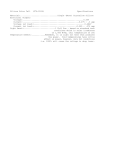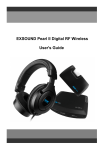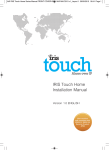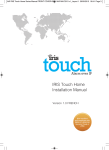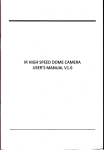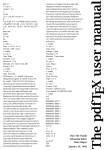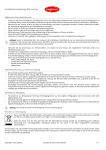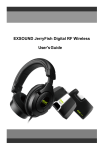Download battery maintenance - matthias-schulze
Transcript
Useful information about batteries and maintenance Extract from our operating instructions - Issue: 22 NOV 2003 schulze elektronik gmbh page 3 Commonly used Terms Final charge voltage: the voltage at which the battery's charge limit (capacity limit) is reached. The charge process switches from a high current to a low maintenance rate (trickle charge) at this point. From this point on further high current charging would cause overheating and eventual terminal damage to the pack. Final discharge voltage: the voltage at which the battery's discharge limit is reached. The chemical composition of the batteries determines the level of this voltage. Below this voltage the battery enters the deep discharge zone. Individual cells within the pack may become reverse-polarised in this condition, and this can cause permanent damage. Memory effect: The real memory effect has been recorded by Nasa, caused by repeated charge / discharge cycles. Nasa has found that full capacity can be regained by overcharging the cells. In modelling applications different effects are responsible for the reduction in cell capacity. The problem can be cured by balancing the cells (see below), and prevented by the measures described in Chapter 4.1.3. Balancing: a method of regaining full (nominal) capacity by alternately charging and discharging the pack, sometimes several times. This process is especially useful after a long period of non-usage (e.g. after purchase, or after several weeks without flying), and is also used to disperse the memory effect (see below). The effect of balancing is to break down the coarse crystaline structure (low capacity) inside the cell and convert it into a fine crystaline one (high capacity). Power-On (- reset): the status of the isl 6 after it has been connected to the car battery. Ready message: charger ready to run the program you have just selected (batteries not connected). The display shows #GO#. C: Coulomb or capacity: Unit of measurement relating to the quantity of charged energy. In conjunction with charge current data this unit is used to determine the recommended / prescribed charge current of a battery of a given capacity. Example: if the charge or discharge current of a 500 mAh battery is 50 mA, we refer to this as a charge or discharge at one tenth C (C/10 or 1/10 C). A, mA: unit of measurement relating to charge or dis-charge current. 1000 mA = 1 A (A=Ampere, mA=Milliampere) Ah, mAh: unit of measurement for the capacity of a battery (Amperes x time unit; h = hour). If a pack is charged for one hour at a current of 2 A, it has been fed 2 Ah of energy. It receives the same quantity of charge (2 Ah) if it is charged for 4 hours at 0.5 A, or 15 minutes (=1/4 h) at 8 A. 4 Useful information about batteries and maintenance 4.1.1General information Do not charge below 0°C, optimum is 10...30°C. A cold cell is not capable of accepting as much current as a warm one. For this reason you must expect differences in charge characteristics if you use fully automatic charge current calculation (in Winter the charging properties will be worse than in Summer). The best working temperature for a Ni-MH cell is 40 ... 60°C. At lower temperatures the cell can not supply higher currents. Caution when using those cells a a receiver battery in a helicopter in the wintertime. The lower the internal resistance of the battery, the higher the charger can increase the charge current for that battery. For a battery charger which sets the current automatically the resistance of the cable is added to the internal resistance. For this reason: use heavy cable (large cross-section), even for receiver batteries, and keep them short. Do not charge via a switch or switch harness! If you wish to measure battery capacity accurately a suitable discharge current is usually 1/10 C. 4.1.2 Reflex charging Charging processes which include a brief discharge pulse definitely have the effect that the battery is several degrees cooler at the end of the process. However, from the point of view of the competition operator this is an undesirable effect, as the cell chemistry can only supply high currents if its temperature is raised to a certain extent. All these effects, whether they actually occur or are simply hearsay, have no practical significance if batteries are correctly handled in the first place. When a battery is full, you can’t fill it any fuller! 1 4.1.3 Memory effect of Ni-Cd & Ni-MH cells If cells are repeatedly stored partially discharged, or are recharged from a half-discharged state, what is known as the memory effect sets in. The cells note that their full capacity is not required, and react by refusing to make it available. One aspect of this is that the crystalline chemical structure inside the cell changes; the cell‘s resistance rises and its voltage collapses under load, with the result that “full capacity” can no longer be exploited at normal discharge currents. Even if reflex charging were to eliminate the memory effect, there is no denying the necessity to store your cells in the discharged state; this applies to Ni-Cd cells and also to Ni-MH cells. A characteristic fact of these cells is that they self-discharge - and the rate of self-discharge is different for each individual cell in a battery pack! If a fully charged pack is left for a considerable time, it will eventually consist of cells of widely varying states of charge. If at this point you ... a) ... give the pack a full charge: the cell with the highest charge will be overcharged, heat up and be ruined, while the cell with the least charge will still not be full after the same period of charging. b) ... discharge the pack: the cell with the least charge will be completely flat first, then reverse polarity and often suffer an internal short-circuit. At the point when this happens, the cell with the most charge is still not yet completely discharged. This is a reliable method of wrecking your most valuable packs and rest assured that reflex charging will make absolutely no difference. However, there is one method of avoiding the problem: discharge cells after use, and recharge them just before use! 4.2 Nickel-Cadmium-batteries (Ni-Cd) Nominal voltage level: 1.2 V / cells. Selecting the fast charge current (manual setting): Charge current = 2 C (never less!) (C=nominal battery capacity) Maximum continous discharge current: Currents of 10 C to 30 C are possible, depending on cell type. Long time storage: Empty i.e. discharged to the discharge voltage cut off level (see maintenance), at low temperature (-20°C to +10°C). Maintenance: Charging: The automatic current setting circuitry (patent applied for) provides optimum protection to your Ni-Cd batteries during charging. The reduced current towards the end of the charge ensures a completely full pack combined with only a slight temperature rise, as you will easily see in comparison with conventional constant current techniques. Do not use the automatic charge current calculation of the Ni-Cd batteries when charging Ni-MH batteries! Discharging: To prevent your cells from memory effect and to keep the full capacity you have to discharge it after use, even when you store it over night (select Auto-D program to discharge down to 0.85V / cell). If a battery is brand-new or used irregularly it is often only possible to balance it completely by carrying out several discharge - charge cycles. Amongst model car operators it is standard practice to erase any memory effect by completely discharging each cell individually via a resistor (approx. 68 Ohm). This deliberately ”unbalances” the pack, but it can cause the automatic charge termination circuitry to switch off the current prematurely during the charge process. For receiver batteries special types such as the Sanyo KR500AAEC / N500AC (lower resistance) are a good choice. Warning: The reduced charge current with 1-6 cells makes the voltage peak in the charge curve very slight, especially with batteries of high nominal capacity. In this situation the charger is sometimes unable to detect the ”full” condition due to the ill-defined peak. schulze elektronik gmbh • prenzlauer weg 6 • 64331 weiterstadt/germany • fon: +49-6150-1306-5 • fax: 1306-99 homepage: http://www.schulze-elektronik-gmbh.com eMail: [email protected] page 2 Useful information about batteries and maintenance Extract from our operating instructions of the chargers 4.3 Nickel-Metal-Hydride batteries (NiMH) Voltage level: 1.2 V / cell. Selecting the fast charge current (no automatic program!): Charge current typical 1 C (never less!) (set a fixed current of, for example, 1.2 A with 1100 mAh batteries, or 3 A with 3 Ah cells). Some modern high-current Ni-MH cells made by particular manufacturers can safely be charged at a higher rate of up to 1.6 C (Panasonic 3000: 3,5 - 4A, GP 3000/3300: 3 A, Saft 3000: 3 A (not if battery is charged inside a transmitter!), Sanyo 3000/3300: 4 - 5A). Typical: The characteristics of lead-acid batteries are quite different to those of the Ni-Cd sealed cell packs which are used as the power source in model aircraft, cars and hydro-boats. They can only tolerate relatively low currents relative to their capacity if their full capacity is to be exploited, and/or the voltage is not to collapse too far. Used as single-cell glowplug energiser batteries and power source in some scale boats. Very low self-discharge rate. 4.5 Lithium-Manganese-Oxide batteries (LiMnO) Maximum continous discharge current: Currents of 5 C to 15 C are possible, depending on cell type. Nominal voltage level: 3.0 V / cell. Long time storage: Empty, i.e. discharged to the discharge voltage cut off level (see maintenance), at low temperature (-20°C to +10°C). Maximum continous discharge current: Up to 1.5 C. Maintenance: To protect your Ni-MH batteries from the memory effect and keep the full capacity, discharge the cells after use down to the discharge voltage limit even when you store it over night. Never discharge by car bulbs or the drive motor (premature charge termination!), but use only the Auto-D programm when the battery type Ni-MH is selected. The cut off voltage is 1 volt / cell. This eliminates the danger of deep discharge termination and polarity reversal (over-discharge). It is important that you take the trouble to give Ni-MH cells when storing at +10...30°C a charge / discharge cycle around every four weeks, otherwise they become tired, and have to be pampered to restore them to full vigour. This involves going through the tiresome business of many repeated charge / discharge cycles. The automatic current setting circuitry (patent applied for) provides optimum protection to your Ni-MH batteries during charging. Do not use the Ni-Cd automatic current selection for Ni-MH batteries! Warning: Never charge fully charged Ni-MH batteries with the Auto C (or ..CD programs): Over-heating and danger of explosion! The cut off automatic is disabled for about the first 5 minutes of charging this could lead to a minimum charge time of about 10 minutes! Amongst model car operators it is standard practice to erase any memory effect by discharging each cell individually via a resistor of approx. 10 Ohms in series to a 1 amp silicon diode (1N4001). Warning: At lower cell counts (1-6) and low charge currents (below 2 C) the battery makes only a very low voltage peak when fully charged. Under those conditions the cut off automatic works less reliable then with higher currents and/or higher number of cells. Typical for Sanyo Twicell and RC3000H cells: High maximum load capacity and voltage level. Selecting the fast charge current: Up to 0.35 C, dep. on cell type. Maintenance: Always store these cells in the charged state. Typical: These cells are particularly recommended as receiver batteries (2 cells required), although correct charging and storage are very important. However, we do not recommend them as slow-fly flight packs, since they have a limited ability to supply high currents, and their useful life varies greatly according to the discharge current and the extent to which they are discharged. Very good weight : energy ratio. Hint: The most common form of this cell type is the „Tadiran“ cell. Tip: Ideally all single cells in a pack should be charged separately; alternatively charge all cells in parallel. 4.6 Lithium-Ion batteries (Li-Io & Li-Po): Nominal voltage LiIo: 3,6 V / cell (SAFT) Nominal voltage LiIo/LiPo: 3,7 V / cell (SANYO, KOKAM) Max. charge voltage LiIo isl 6: 4,1 V +-40mV / cell (SAFT) (absolute limit 4.3 V / cell) LiPo isl 6: 4,2 V +-50mV / cell (MoliCel) Min. discharge voltage LiIo isl 6: 2,5 V / Z.(MoliCel), 2,7V/Z.(SANYO) (absolute limit 2.3 V / cell) LiPo isl 6: 3,0 V / cell (KOKAM) Number of cells to be selected on the isl 6: Nominal voltage of LiPo-pack div.by nominal cell-voltage = cell count. --> 11,1 V LiPo-pack divided by 3.7 V => select 3 cells! If you would select more, the pack would explode during charging! Example: The Kokam TP8200 3s4p pack consists of 12 cells. 4 of 2050mAh are connected parallel (4p) -> 4 * 2,05 Ah = 8200mAh. 3 of the parallel cells are connected in series (3s)-> 3*3,7V= 11,1 V. Typical for Panasonic P3000NIMH cells: High maximum charge capacity and voltage level. Selecting the fitting cell type: Select that battery type from the isl 6 menue which characteristics match best with the data sheet of the battery manufacturer. Typical for GP GT3000 / 3300 cells: Extremely high charge capacity, good voltage level. Can be discharged with medium currents (about 40...45 A). Selecting the fast charge current: Charge current = 1 C (SANYO / KOKAM) or less (0,7 C PANASONIC) (C = nominal battery capacity). 4.3 Lead-acid batteries (Pb) and VRLA (valve regulated lead-acid) batteries Nominal voltage level: 2.0 V / cell. Charge voltage level: 2.3 V / cell; 2.42 V / cell for 3 hours. Min. discharge voltage: 1.7 V / cell (this reduces lifetime). Number of cells to be selected on the isl 6: Nominal voltage of the battery to be charged divided by the nominal voltage level of lead-acid battery cells = cell count. Example: 12 V-Lead acid battery divided by 2,0 V => 6 cells. Selecting the fast charge current: Charge current = 0.4 C (C = nominal battery capacity) Maximum continous discharge current: Typically 0,2 C, short time load up to 1 C. Long time storage: Full at low temperature, more precise: at +10°C up to 12 month, at +10...20° max. 9 month, at +20...30°C max 6 month, at +30...40°C 3 month. Charge again after this period. Maintenance: In contrast to Ni-Cd/Ni-MH batteries, lead-acid batteries must be fully recharged after use in order to maintain full capacity. The nominal capacity can be reduced very quickly by incorrect handling (overloading, repeated 100% discharges, and especially deep-discharges). Please observe the battery manufacturer’s recommendations. Maximum continous discharge current: Up to 4 C (very new types more), depending on cell type. Long time storage: Empty, i.e. discharged to the discharge voltage cut off level (see maintenance), at low temperature (-20°C bis +10°C). Maintenance: Discharge with 1 C down to above listed discharge voltages. Always store these cells in the discharged state, if stored fully charged, the result can be a permanent reduction in capacity. When stored at +40°C or more charge additional every two months. Typical: They are very popular as power supplies for sail winches (2 cells). Their limited ability to supply high currents means that they are only suitable as flight packs with more than 20 minutes flight time (slow flyers, Piccolo, Hornet, Logo10). Very good energy : weight ratio. Hint: Many manufacturers direct how many cells are allowed to use in series and/or parallel use. The exact technical term of a Li-Po cell is Lithium-Ion-Polymer battery, the "true" Lithium-Polymer cells work only with higher temperatures of more than 60°C. schulze elektronik gmbh • prenzlauer weg 6 • 64331 weiterstadt/germany • fon: +49-6150-1306-5 • fax: 1306-99 homepage: http://www.schulze-elektronik-gmbh.com eMail: [email protected]


